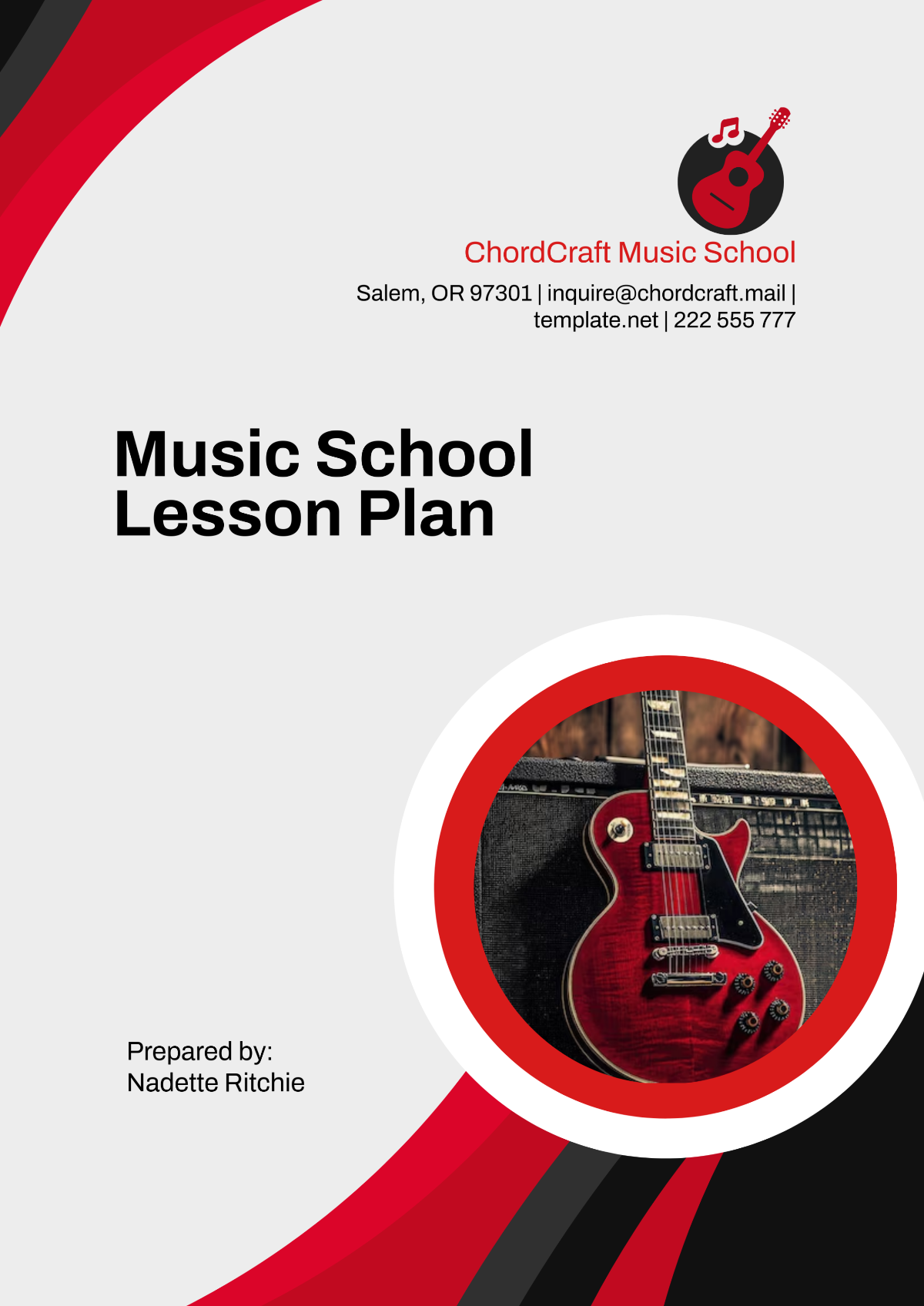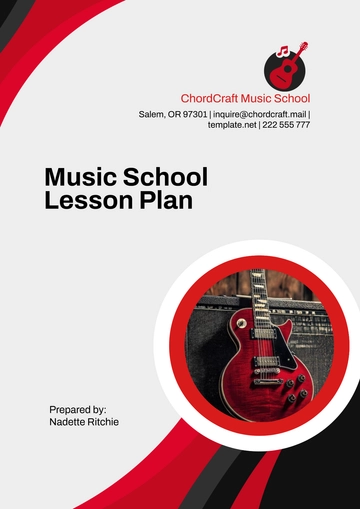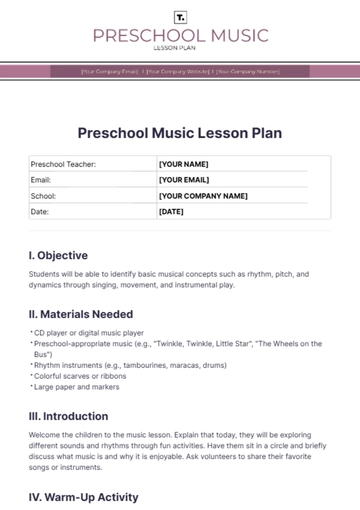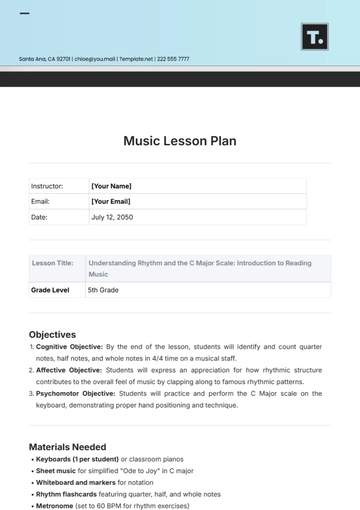Free Music School Lesson Plan

I. Lesson Information
This lesson will focus on teaching beginner-level piano students to play the well-known children’s song, "Twinkle, Twinkle Little Star," in C major. The goal is to help students develop fundamental piano skills, including proper hand positioning, rhythm accuracy, and basic sight-reading techniques. The students will practice using both hands, with the right hand playing the melody and the left hand providing simple chordal accompaniment.
This lesson will provide a supportive environment for students to gain confidence as they begin to play with both hands together, improving their overall coordination. The duration of the lesson is 45 minutes, allowing for ample time to introduce new concepts, practice, and receive feedback.
II. Lesson Objectives
A. Primary Goal
The primary goal of this lesson is to teach students to play "Twinkle, Twinkle Little Star" with both hands, focusing on correct hand positioning, note accuracy, and rhythm. By the end of the lesson, students will be able to perform the piece smoothly, using their right hand for the melody and their left hand for basic accompaniment. This piece is a great starting point for building the foundation of playing simple, recognizable songs with two hands.
B. Specific Skills/Concepts
The lesson will focus on improving students’ ability to read music, specifically quarter notes and half notes, and applying them to a simple melody. Students will also practice finger placement, ensuring proper curvature and relaxed hand positions to facilitate easier playing. Additionally, the lesson will emphasize rhythm and timing, helping students gain an understanding of note values and their relationship to the beat.
C. Learning Outcomes
By the end of the lesson, students will demonstrate the ability to play "Twinkle, Twinkle Little Star" in C major with accurate finger placement, rhythm, and coordination between their hands. Students will also be able to identify and play the notes in the piece, recognizing them on the sheet music and translating them to the piano. Finally, students will improve their confidence in playing piano with both hands working together, creating a more cohesive sound.
III. Materials Needed
A. Instruments
Each student will need access to a piano or keyboard, with a fully functional range of keys, preferably with at least 61 keys. It is important that the instrument is tuned correctly for accurate pitch and tone quality. The availability of an adjustable bench or stool is also essential to ensure proper posture and hand positioning during the lesson.
B. Sheet Music/Scores
The students will use a simplified version of "Twinkle, Twinkle Little Star" written in C major. The sheet music will include the melody in the treble clef for the right hand and basic chord symbols for the left hand accompaniment. Printed copies of the sheet music will be distributed to each student, and digital copies will be available on a projector or screen for group reference.
C. Technology/Tools
A metronome will be used throughout the lesson to help students practice maintaining a consistent tempo. This will be particularly important during the transition between practicing hands separately and playing the piece hands together. Additionally, the teacher will use a digital tuner (for piano tuning) or a smartphone app to ensure the piano is in tune, if necessary.
D. Other Supplies
Each student should have a pencil to mark their sheet music, especially for writing fingerings or dynamics. Music staff paper will be available for students to practice writing the notes they are learning. Whiteboard markers and a small whiteboard will be used to write out any concepts, such as the time signature or note values, for visual reference.
IV. Warm-Up Activity (5-10 Minutes)
A. Purpose
The warm-up activity serves to prepare students both physically and mentally for the lesson, promoting muscle relaxation and mental focus. This time will also help students refresh their memory of previous lessons and reinforce basic concepts. The warm-up will address areas like finger flexibility, hand coordination, and rhythm, all of which are essential for playing the assigned piece.
B. Suggested Activities
Scales (C Major Scale)
Students will start by playing the C major scale, first with their right hand, then with their left hand, focusing on proper finger placement and smooth, even playing. This exercise will also encourage students to familiarize themselves with the C major scale, the key of the piece they are learning. The teacher will emphasize playing slowly and evenly, ensuring accuracy in finger transitions and tone quality.
Rhythm Exercise
The class will clap along to a rhythm exercise that incorporates quarter notes and half notes, allowing students to internalize the beat before applying it to their piano playing. The teacher will demonstrate different rhythmic patterns, then have the students repeat them, clapping along to a metronome set at a moderate tempo. This exercise will help students develop a strong sense of timing and rhythm, which is essential for ensemble playing and solo performance.
Hand Positioning Exercise
Students will practice hand positioning by placing both hands on the piano keyboard, focusing on maintaining a relaxed hand posture with curved fingers. The teacher will guide students to adjust the wrist and arm height for optimal playing technique, avoiding any strain. This exercise will also help students become more comfortable with the physicality of playing and reinforce the importance of proper posture.
V. Main Instruction/Activities (20-30 Minutes)
A. Introduction to New Material
Explain the Concept or Skill
The teacher will introduce the song "Twinkle, Twinkle Little Star," explaining that the melody will be played with the right hand while the left hand will play simple chords in the accompaniment. The concept of playing with both hands will be explained step-by-step, starting with playing the right hand alone. The teacher will also introduce the time signature (4/4) and the use of quarter notes and half notes in the piece.
Demonstration by Teacher
- The teacher will demonstrate the first few measures of the piece, playing the right-hand melody and the left-hand accompaniment slowly. The teacher will model proper hand positioning, finger placement, and even rhythm to ensure that students understand the mechanics of playing both hands together. A slow demonstration will help students visualize and absorb the technique before attempting it themselves.
B. Guided Practice
Student Participation
Each student will be asked to play the right-hand melody of the song, one measure at a time, while the teacher provides guidance on fingerings and note accuracy. The teacher will walk around the room to give individual support, especially to those who may be struggling with certain notes or transitions. After the right-hand part is mastered, the teacher will guide students in adding the left hand, one hand at a time.
Breakdown of Material
The song will be broken into small sections, first focusing on the right-hand melody and then introducing the left-hand accompaniment. Students will practice playing each section separately, and once they are confident, they will gradually combine both hands. The teacher will ensure students understand how the two hands interact, especially in terms of rhythm and timing.
Student Feedback
The teacher will provide positive feedback, acknowledging progress, and giving constructive tips for areas that need improvement. If a student is struggling with a specific section, the teacher will give focused attention, offering suggestions to simplify or slow down the difficult part. Peer feedback will also be encouraged as students play for each other during practice time.
C. Group Activity
Ensemble Play or Collaborative Work
The class will come together to play the piece as a group, with each student playing either the right-hand or left-hand part, depending on their individual level of confidence. This ensemble approach will help students listen to each other and develop an awareness of how the parts fit together. The teacher will lead the group, ensuring everyone stays in time and plays with proper dynamics.
Peer Feedback
After the group practice, students will be encouraged to offer positive feedback on each other’s playing. The teacher will guide students to focus on giving constructive comments, such as “I liked how you played the left-hand chords clearly” or “Try to keep your right-hand melody even.” This feedback session will foster a sense of collaboration and mutual support among students.
VI. Independent Practice (10-15 Minutes)
A. Student’s Individual Work
During independent practice, students will work individually on the piece, playing the right-hand melody and left-hand accompaniment separately. The teacher will circulate the room, offering help to students who need additional support. Students will focus on mastering one section at a time, ensuring that they can play each hand confidently before combining them.
B. Teacher Circulation/Observations
The teacher will move between students to observe their technique, listening for areas that need adjustment, such as uneven rhythm or incorrect fingering. The teacher will give specific feedback to each student based on their individual needs, providing encouragement and making minor corrections. For students who seem to be progressing well, the teacher will challenge them to increase the tempo slightly or add dynamic expression to the piece.
C. Focus Areas for Practice
The teacher will suggest specific areas for improvement, such as focusing on rhythm consistency, practicing one hand at a time, or slowing down difficult transitions. Students who are ready will be encouraged to try playing hands together at a slower tempo. The teacher will remind students to take breaks and avoid playing for too long without rest to prevent fatigue.
VII. Assessment and Evaluation (5-10 Minutes)
A. Observational Assessment
The teacher will assess students’ progress based on their performance during the lesson, observing whether they are able to play both hands together, follow the rhythm, and maintain correct hand positioning. The teacher will also pay attention to whether students can identify the notes they are playing and make connections between the written music and the piano keys. This assessment will help the teacher gauge whether students are ready to move forward or need additional practice on specific concepts.
B. Performance Evaluation
At the end of the lesson, each student will be asked to perform the first few measures of "Twinkle, Twinkle Little Star" for the class. The teacher will assess each student’s performance, focusing on areas such as hand coordination, note accuracy, and rhythm. Students will be encouraged to play at a comfortable tempo and may be asked to repeat the performance for further practice and improvement.
C. Verbal/Informal Check
The teacher will ask questions to gauge students’ understanding, such as “What are the note names for the first two measures?” or “How do we count the rhythm for quarter notes?” This will help reinforce theoretical knowledge and ensure that students understand the concepts they have been practicing.
VIII. Conclusion (5 Minutes)
A. Recap Key Points
The teacher will summarize the key concepts covered in the lesson, including the importance of hand positioning, rhythm accuracy, and coordination between both hands. The teacher will also emphasize the progress students have made and encourage them to practice regularly at home. The lesson will be concluded on a positive note, reinforcing the idea that improvement comes with consistent practice and effort.
B. Student Reflection
Students will be asked to reflect on their experience during the lesson, such as what part of the song they found most challenging or what they felt most proud of achieving. This reflection encourages self-awareness and helps students take ownership of their learning process. The teacher will provide feedback and encouragement, emphasizing their strengths while gently addressing areas for improvement.
C. Closing Activity
To wrap up the lesson, the teacher will invite the class to play the song together one final time, even if at a slow tempo, to showcase their efforts and provide a sense of accomplishment. This final play-through will give students a chance to hear their collective progress and leave the lesson feeling positive and motivated.
IX. Assignments/Homework
A. Practice Guidelines
Students are encouraged to practice the right-hand melody and left-hand accompaniment separately at home, before attempting to play both hands together. Students should practice playing slowly and with a metronome to help maintain consistent timing. The teacher will remind students to focus on correct finger placement and smooth transitions between notes.
B. Repertoire to Practice
Students should continue practicing "Twinkle, Twinkle Little Star" until they can play it comfortably with both hands. The teacher will advise students to break the piece into small sections and master one section at a time. By practicing this song regularly, students will develop the basic skills needed for more complex pieces in the future.
C. Theory Homework
For theory practice, students will be asked to write out the first few measures of the song on staff paper, labeling the notes, time signature, and other musical markings. The teacher will explain how this reinforces note recognition and music reading skills. The assignment will also include a question asking students to identify the rhythm of quarter and half notes.
X. Reflection (Post-Lesson)
A. Teacher’s Reflection
After the lesson, the teacher will reflect on the progress made by the students, noting which students were able to play hands together successfully and which areas seemed to be challenging. The teacher will assess whether the teaching pace was appropriate and whether students engaged with the material. If needed, adjustments will be made for the next lesson, focusing on reinforcing areas where students struggled.
B. Adjustments for Future Lessons
Based on student feedback and the lesson outcomes, the teacher may adjust the difficulty of future lessons. For example, if students struggled with hand coordination, more exercises focusing on hand independence might be introduced. The teacher may also consider offering more time for rhythm exercises if timing was a challenge during the lesson.
- 100% Customizable, free editor
- Access 1 Million+ Templates, photo’s & graphics
- Download or share as a template
- Click and replace photos, graphics, text, backgrounds
- Resize, crop, AI write & more
- Access advanced editor
The Music School Lesson Plan Template from Template.net is a fully editable and customizable tool designed for music educators. With the intuitive AI Editor Tool, you can effortlessly tailor lesson plans to meet the unique needs of your students. Streamline your teaching process with this professional template, ensuring a seamless, organized approach to every lesson.



